The first time I cooked Egwusi soup, I was so confident I could impress my mom. I poured in the melon seeds like a chef on TV and waited for magic. Ten minutes later, I had a pot of Egwusi cement, thick, stiff, and nothing close to the creamy, lumpy dream she made most Saturdays. She took one look and said, “Next time, call me before you waste good palm oil.” Now, after many kitchen “experiments,” I am going to teach you how to make lumpy Egwusi soup recipe-regional variations you’ll love.
It’s that hearty, nutty, melt-in-your-mouth kind of soup that hugs your taste buds and reminds you of home.
In this post, I’ll show you how to make Egwusi soup that actually turns out right—no clumps of disappointment or bland taste. You’ll learn how different regions across Nigeria twist this classic in their own delicious way. From Yoruba-style smoothness to Igbo-style lumps that hold flavor like gold, we’ll explore them all.
So, grab your spoon, clear your kitchen space, and let’s turn melon seeds into something worth bragging about.
What Is Egwusi Soup?
Egwusi soup is a rich, nutty Nigerian soup made from ground melon seeds. Melon is a seasonal plant mostly grown in Northern part of the country that is made available all year long. The seeds are extracted from the pod, peeled and dried. Each spoonful of melon soup is thick, lumpy, and full of flavor from palm oil, meats, and leafy greens.
Across Nigeria, every region adds its twist. The Igbo version is bold and hearty, while the Yoruba style is smoother and lighter. Some people add bitter leaf for a slightly earthy taste; others stick with Ugu or spinach for that fresh green look.
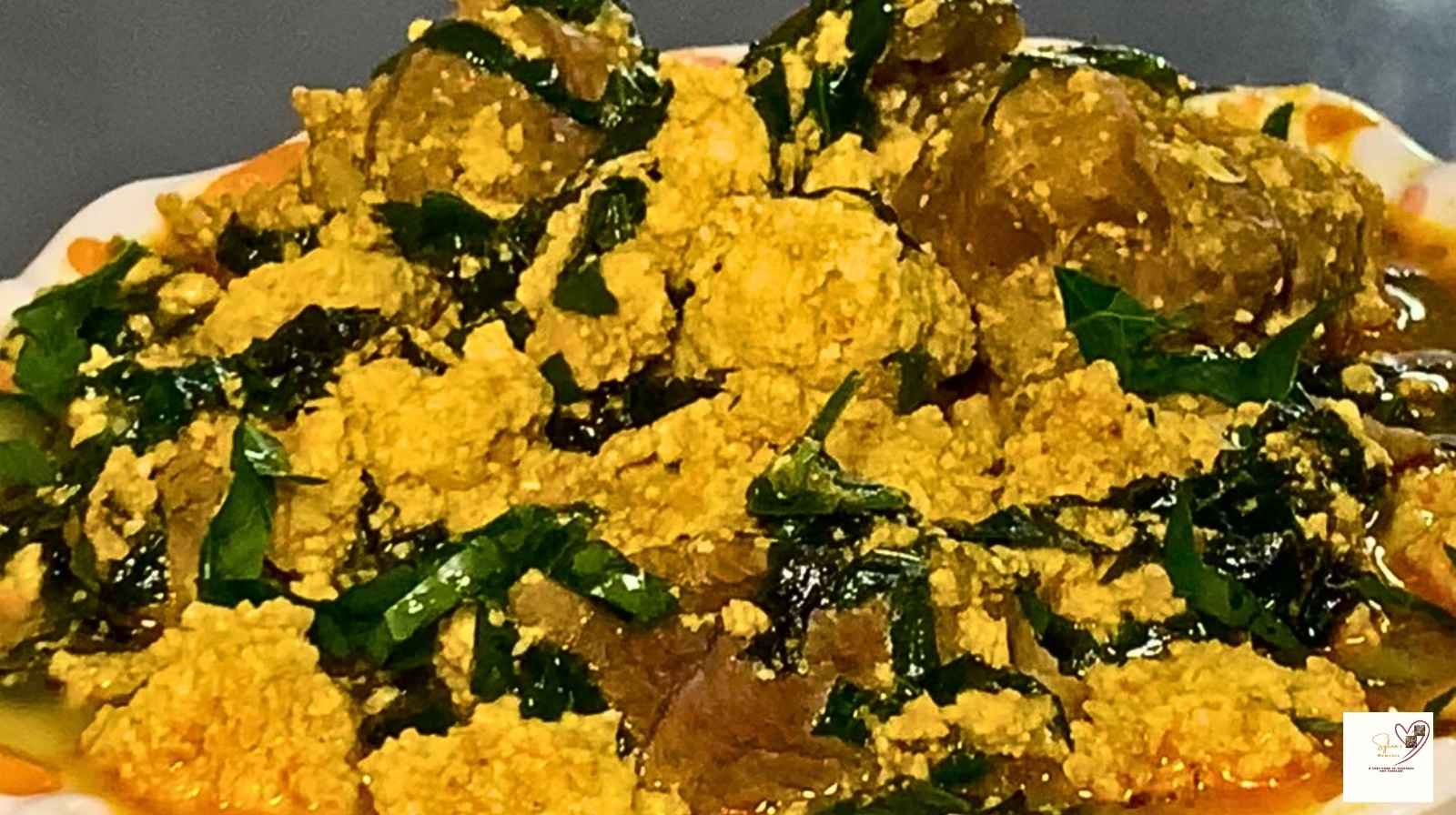
Some of the other names egusi goes by across the region include:
- Yoruba : Egusi / Egushi (Ẹ̀gúṣí)
- Hausa : Agusi, Agushi (via Yoruba)
- Twi : Akatowa.
- Ga : Agushi, Egushi.
- Igbo : Élìlì, Énìnì, Ekeke, Ahụ, Élìlè, Ilolo, Iroro, Éyìyè, Ogili, Nwanru, Ègwúsí (Onitsha Igbo; via Yoruba)
- Edo : Ogi, Ikpogi.
- Ibibio, Efik : Íkpán, Ikon.
Egwusi Soup Ingredients → What You Need & Substitutes
Preparation Time: 20 minutes
Cooking Time: 45–50 minutes
Servings: 6–8 people
- Ground Egwusi [2 cups] Substitutes to Egwusi → Pumpkin seeds or Sunflower seeds.
- Protein mix– [ 1 kg ] beef, goat meat, tripe , smoked fish or stockfish. Substitutes → Smoked turkey or Shrimp
- Palm oil [1 cup]
- Vegetable- Ugu → fluted pumpkin leaves or Uziza leaves [ 2 cups ] Substitutes → Spinach, collard greens, or kale
- Crayfish [ 1 cup]
- Uziza seed → Optional [ 8 pieces ]
- Habanero pepper [ 1 piece ]
- Seasoning cubes [2 cubes]
- Salt [ To taste ]
- Okpei → Optional- Dried fermented Locust Bean [ 1 piece ]

Step by Step guide to Lumpy Egwusi Soup Recipe
Ingredients Preparations
Step 1: Prepare and Season Your Meat
Start by washing your meat thoroughly. Then place it in a pot and season it with salt and seasoning cubes and add a little water and let it boil.
Keep cooking until the meat becomes soft and juicy after which you separate the boiled meat from the stock. This broth (or stock) will serve as the flavor base for your Egwusi soup, so don’t pour it out. It’s pure gold.
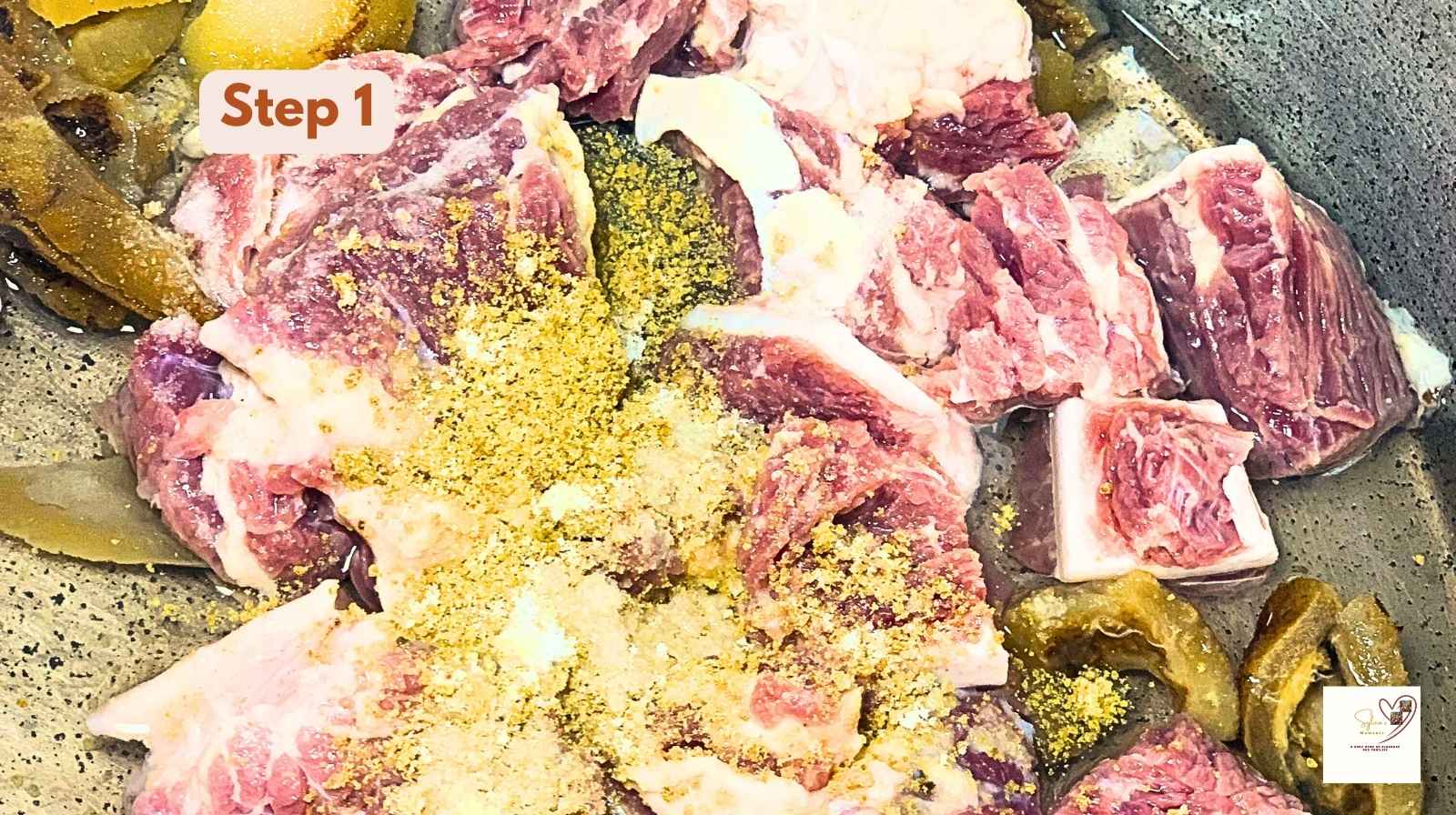
Step 2 : Lumpy Egusi Preparation
In a clean bowl, pour in your grinded Egwusi. Add a little quantity of water into it and turn clockwise with turning stick until they cluster into a very thick lumps. Set it aside.
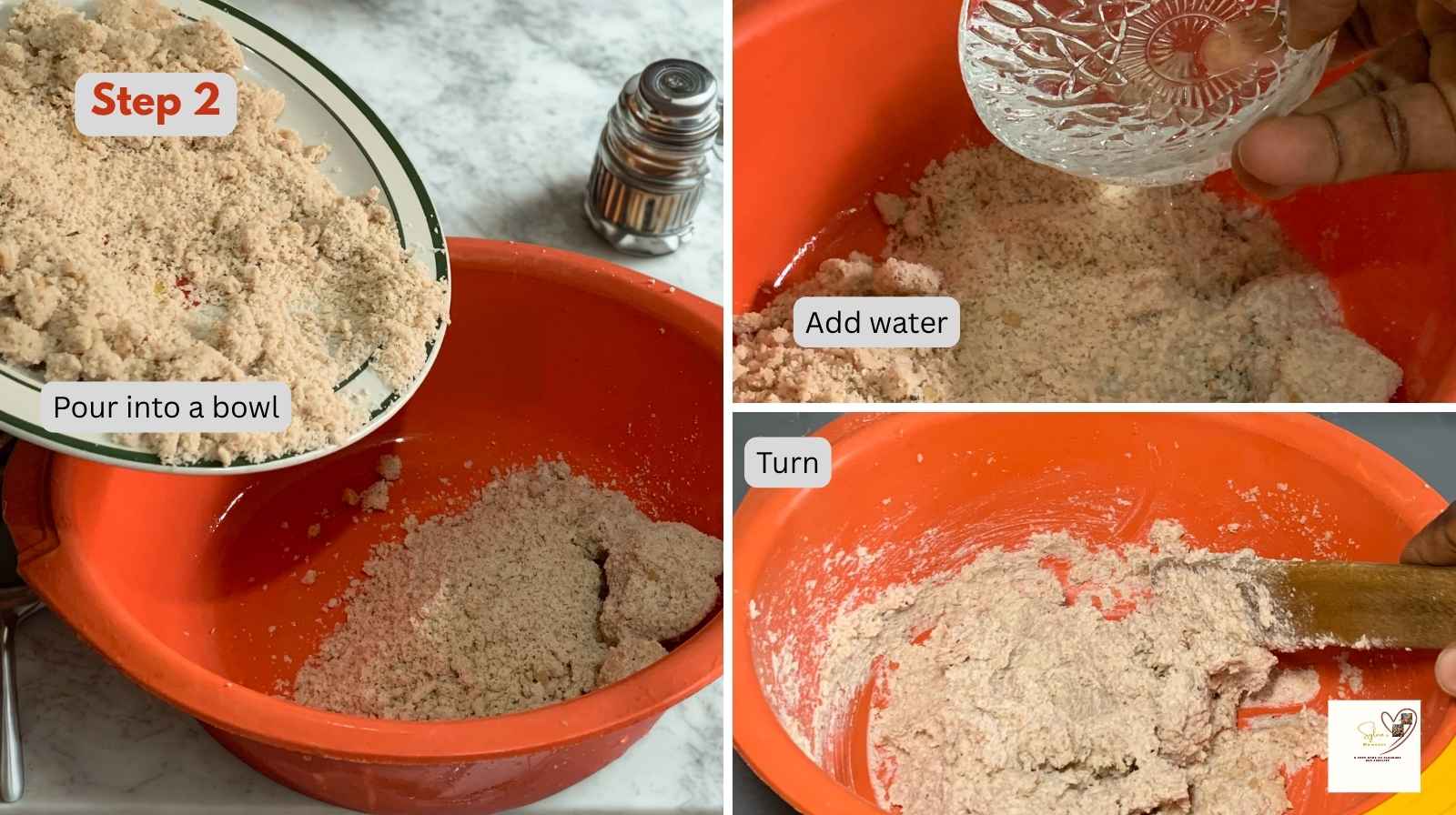
Step 3 : Blend your Pepper, Crayfish, Uziza seed and Okpei. Wash and slice your vegetables and set aside.
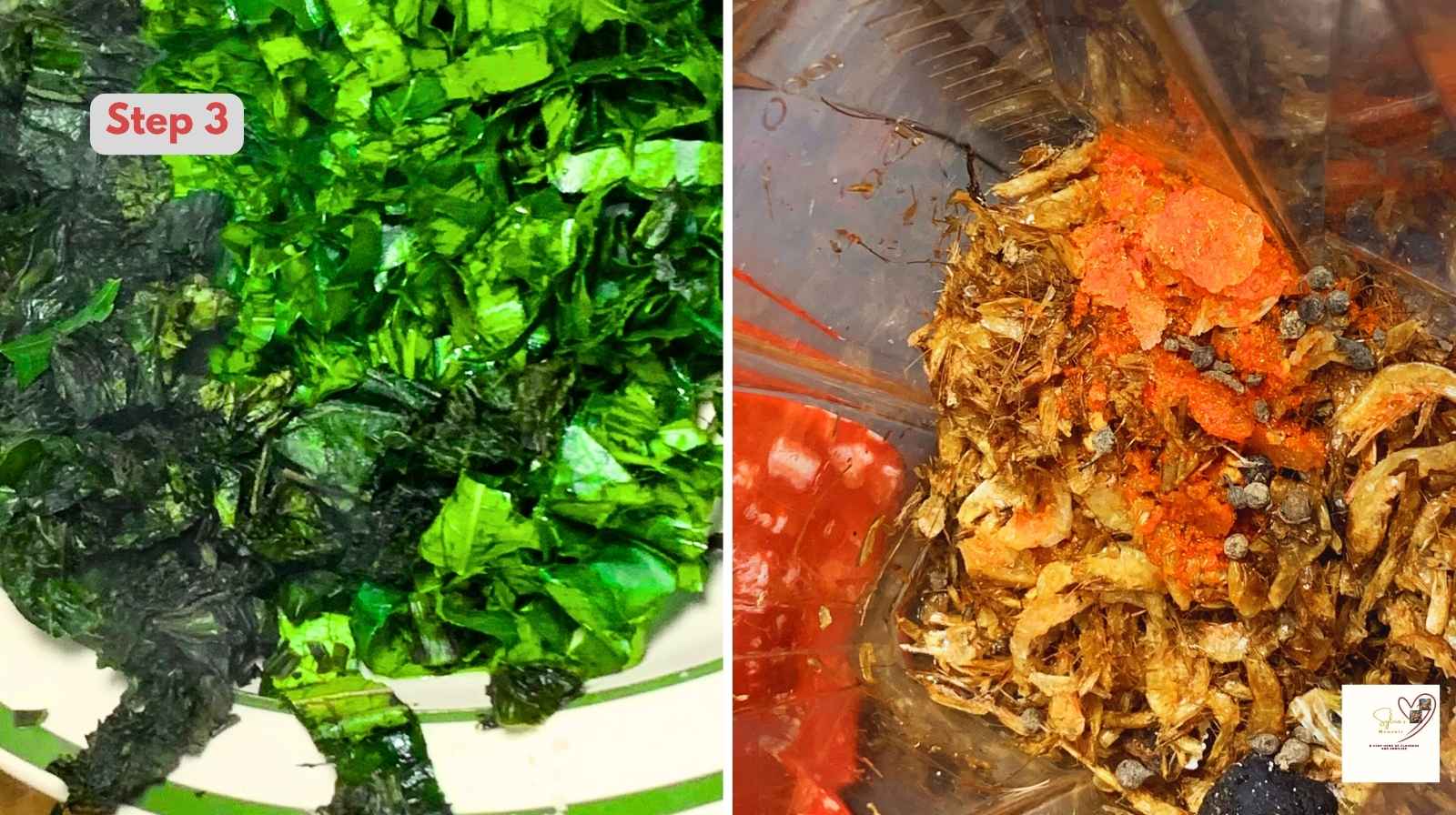
Soup Preparation
Step 4 :
In a clean pot, transfer the meat broth and make up with the quantity of water needed for the soup. For the above mentioned quantity of ingredients, make up the water to measure up to about 5 cups. Bring the water to a boil and add the quantity of palm oil needed for the soup. Allow the oil to boil and spread evenly.
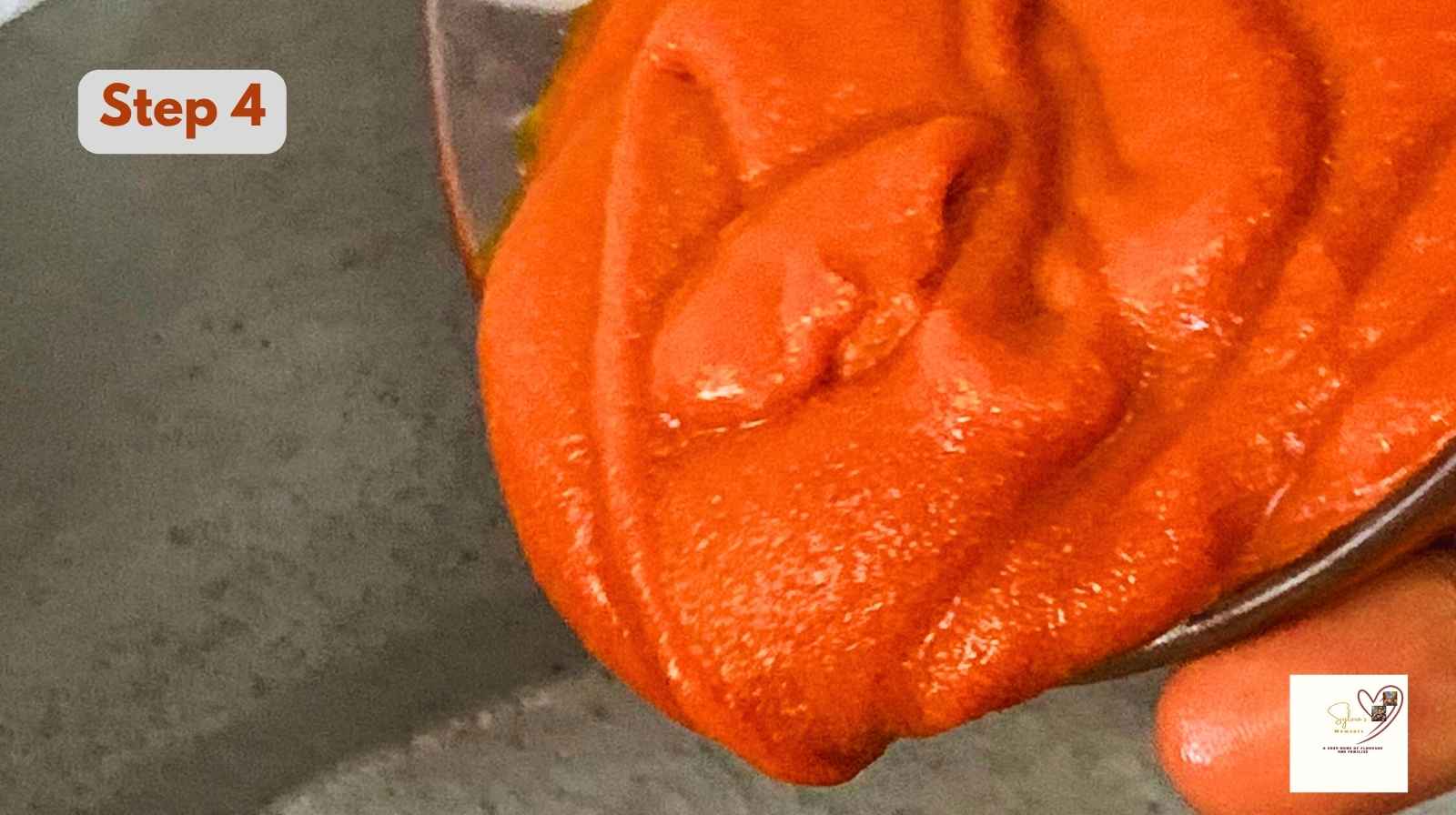
Step 5 :
Add the lumpy egwusi into the boiling water after the oil has cooked .It is advisable to add them in big balls bit by bit into the hot water. Cover the pot and allow to boil for 10 minutes. Carefully Remove the boiled Egwusi balls and add in a little mortar or bowl. Slightly pound a little and set aside .
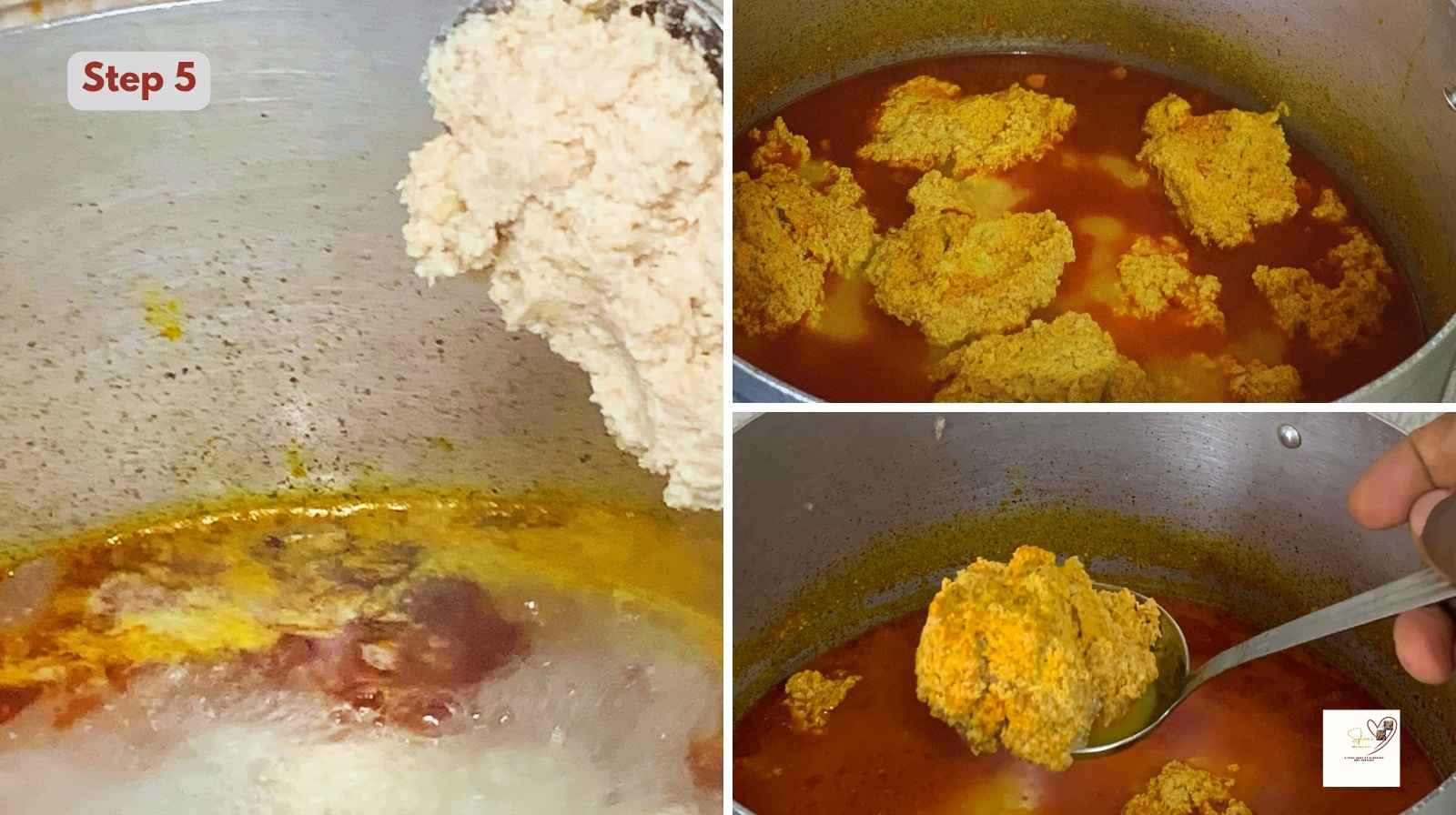
Step 6 : Build the Soup
In the cooking pot, blended crayfish and Pepper Mix .Stir well and allow it to come to a boil. After about 7-8 minutes, add your seasoning and salt.. At this point, pour in your cooked proteins and adjust the taste. Continue stirring every 3 minutes to avoid burning underneath the pot.

Step 7: Add the Ground Egwusi
Carefully add the slightly pounded Egwusi into the pot and cover for about 3 minutes. Stir gently .
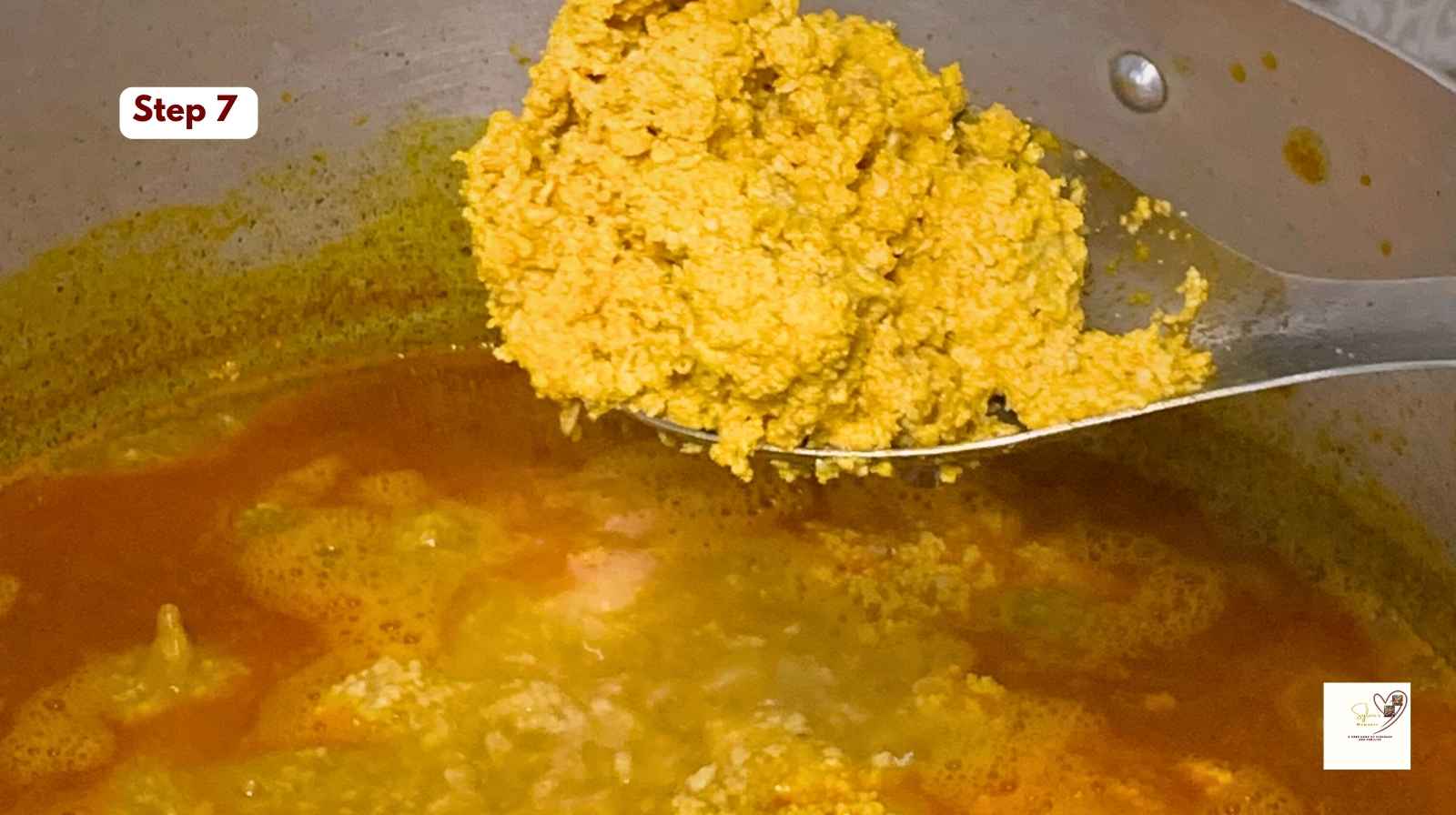
Step 8 : Add the Vegetables, final simmer and serve
Add your vegetables and put off the light .The vegetable will eventually be steamed with the heat .It is not advisable to cook vegetables for a long time. Serve your soup and enjoy.
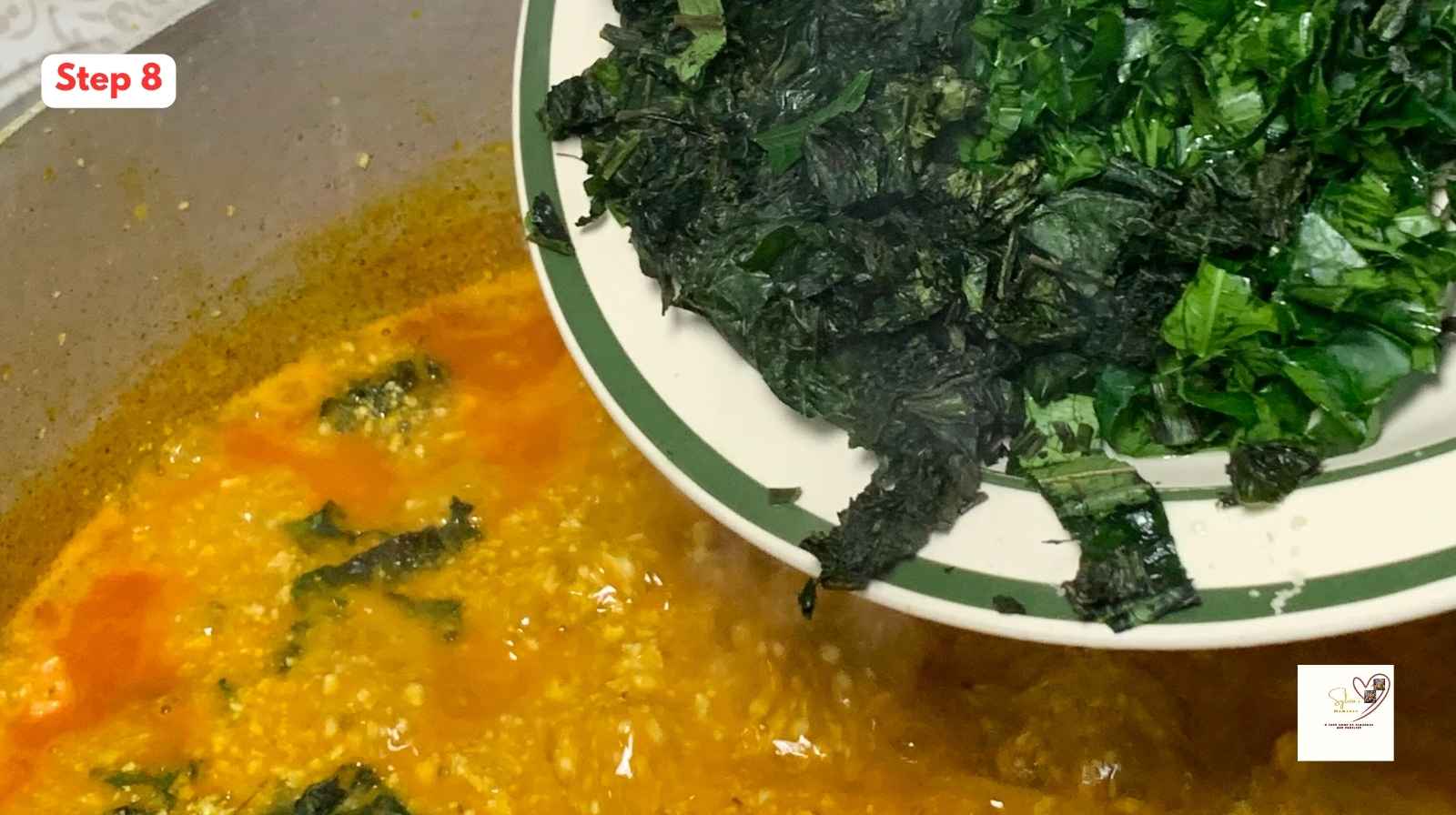
Pro Cooking Tips
-
Avoid grainy texture: Don’t add too much water first before cooking. Adjust the texture as you go..
-
Balance your meat and fish: Too much of either can overpower the melon flavor. Aim for a mix that blends well.
-
Don’t skip crayfish: It’s small but powerful, it brings out that authentic Nigerian flavor.
-
Taste as you go: Every ingredient matters. Add a little, stir, and taste before adding more.
-
Use clean Egwusi seeds: Grit or sand can ruin the entire meal, so always rinse or sift your seeds before grinding.
Tasty Variations of Egwusi Soup to Try
-
Goat Meat Egwusi Soup: Rich, bold, and perfect for special occasions.
-
Smoked Turkey Egwusi: Great for a smoky twist that’s popular abroad.
-
Seafood Egwusi: Combine shrimp, crab, and fish for a coastal vibe.
-
Vegetarian Egwusi: Skip the meat and load up on mushrooms, tofu, or more vegetables.
-
Egwusi with Okra: Add a handful of sliced okra for a smooth, stretchy texture
Regional Variations and Styles of Egwusi Soup
Although the base of Egwusi soup stays the same, every region in Nigeria adds its own touch. Each version reflects local taste, culture, and ingredients, making this soup a true celebration of diversity.
I could remember travelling to Lagos State at a time and ordered egwusi soup from a local restaurant. To my greatest surprise, the soup was light and smooth and completely different from the version I know. That was when it dawned on me that the soup has many varieties.
Igbo Style Egwusi Soup
To begin with, Igbo-style Egwusi is thick, hearty, and proudly lumpy. People in the East love it rich, with beef, stockfish, and dry fish cooked together for deep flavor. Instead of stirring too much, they let the Egwusi form soft lumps that soak up all that savory goodness. Served with pounded yam or fufu.
Yoruba Style Egwusi (Egusi Ijebu)
On the other hand, Yoruba-style Egwusi, especially Egusi Ijebu, is smoother and lighter. Their lumpy egwusi soup recipe includes blended pepper and tomatoes for a slightly tangy taste. Moreover, Yoruba cooks fry their Egwusi longer, allowing the oil to float beautifully on top. The result is a golden, fragrant soup that pairs perfectly with amala, eba, or rice. Check Nigeria Rice Recipes for Different Occasions.
Hausa Style (Agushi Soup)
Meanwhile, the Hausa Agushi soup from Northern Nigeria takes a spicier, lighter route.Lumpy egwusi soup recipe has more vegetables and sometimes a touch of groundnut paste or tomato for extra depth. With spinach or moringa leaves and less oil, it feels fresh yet flavorful. When paired with tuwo shinkafa, it becomes pure northern comfort food.
Modern Twists
As Nigerians travel and experiment, modern Egwusi variations keep evolving. Some cooks swap palm oil for olive oil, while others add seafood, tofu, or even okra for a creative twist. Regardless of the version, one thing never changes ; that nutty, aromatic essence that makes Egwusi taste memorable.
Serving Suggestions and Pairings for Egwusi Soup
Wondering what goes best with your rich, lumpy egwusi soup recipe? Here are some tasty pairings to try:
-
Pounded Yam: Soft, stretchy, and the ultimate classic combo for Egwusi.
-
Eba (Garri): Slightly firm with a mild flavor that balances the soup’s richness.
-
Amala: Earthy and smooth — perfect for Yoruba-style Egwusi.
-
Fufu or Semovita: Light and filling, great for soaking up every drop of the soup.
-
White Rice: A modern twist that pairs well for a simple, hearty meal.
-
Boiled or Fried Plantain: Adds sweetness that complements the nutty flavor of Egwusi.
-
Moi Moi or Steamed Veggies: Perfect for color, nutrition, and extra flavor. Check Moi-moi Recipe here.
Health Benefits & Nutrition of Egusi Soup
- High in Protein and Essential Amino Acids
The U.S. Dietary Guidelines classify nuts and seeds in the ‘Protein Foods group . Melon seeds (egusi) fit this recommendation. Melon seeds are rich in protein. Studies show they provide all essential amino acids needed by the body. This helps with muscle repair, growth, and healthy cell function.

2. Mineral Powerhouse
Egusi soup supplies minerals like magnesium, phosphorus, potassium, calcium, zinc, and iron. These minerals support bone health, muscle function, and overall metabolism.
3. Good Source of Healthy Fats
The fats in egusi are largely unsaturated (especially linoleic acid). These fats help lower bad cholesterol (LDL) and support heart health when used in balance and not over-oiled. “According to the American Heart Association, adults need about 0.8 g of protein per kg of body weight daily ; Egwusi seeds help you meet part of that.”
4. High in Dietary Fiber
The leafy greens (ugu, spinach, etc.) included in many traditional Egwusi recipes add fiber. Fiber supports digestion, helps you feel full, and stabilizes blood sugar levels.
Frequently Asked Questions (FAQ)
1. Why does my Egwusi soup taste too fishy?
That strong fishy taste always comes from dried fish, fresh fish or fish stock used. If you are not a fan of the fishy flavor, use other proteins instead of fish. Also, use less amount of dried fish.
2. How can I avoid sand or grainy texture in Egusi soup?
Always rinse your vegetables and stockfish properly. Then, before grinding your egusi, make sure the milling machine is properly cleaned. When buying Egusi, always go for hand peeled ones instead of machine peeled as they are more neat and clean.
3. Can I use pumpkin seeds instead of melon seeds?
Yes, pumpkin seeds work well as a healthy substitute. They give lumpy egusi soup a slightly nuttier flavor but still create that creamy, rich Egwusi texture.
4. Which green leaf works best for Egusi soup?
Ugu (fluted pumpkin leaf) is the favorite in most Nigerian homes. However, spinach or bitter leaf are great alternatives, it depends on whether you want a mild or earthy taste.
5. Can I make vegetarian Egwusi soup?
Absolutely! Skip the meat and fish, and add mushrooms or tofu instead. The melon seeds still provide enough protein and that delicious, taste.
Storage of Egusi Soup
I always portion my soup in soup containers according to per serving. By so doing, the soup remains fresh and the vegetables intact anytime it is served.
Egwusi soup can last 3 – 5 days in the fridge and up to a month in the freezer.

Love this recipe? Check out other traditional soup Recipe → Nigerian Oha soup, Oil-less Okro Soup and Bitterleaf soup.
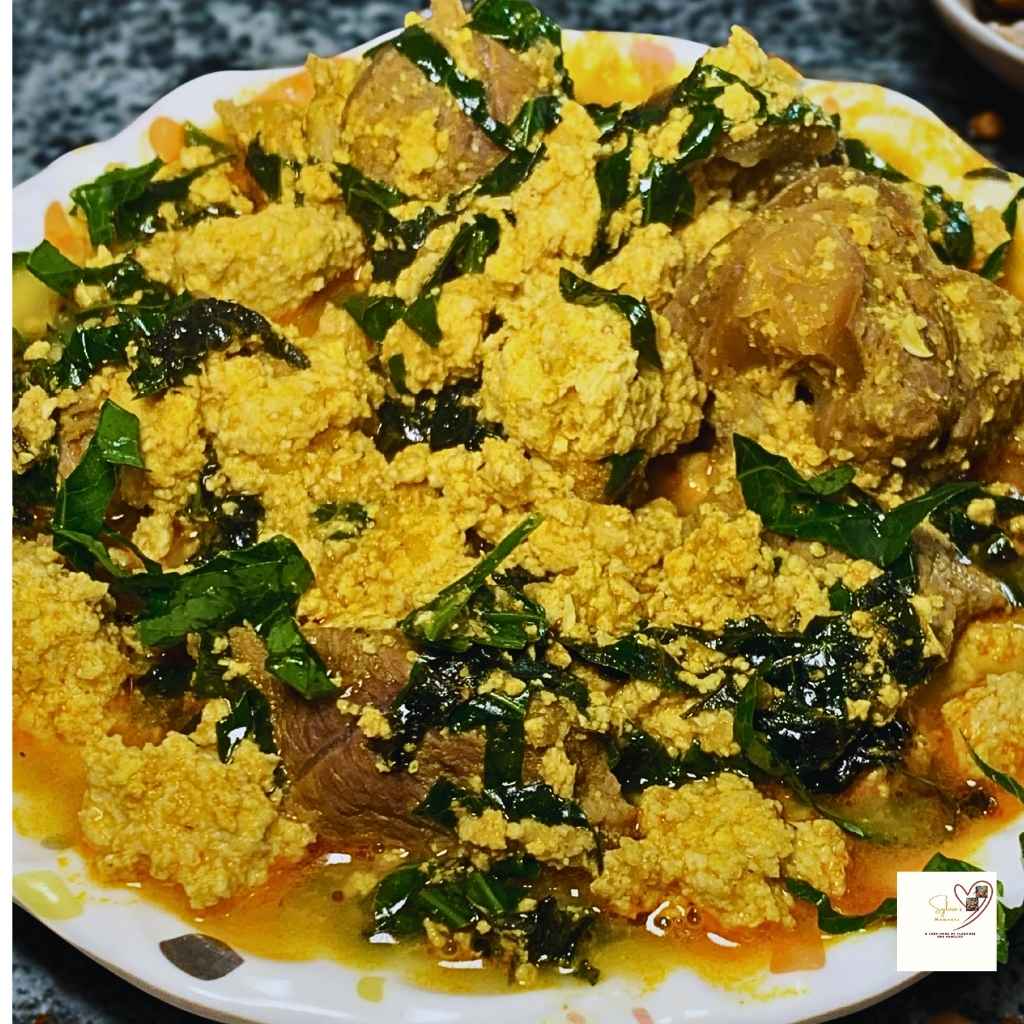
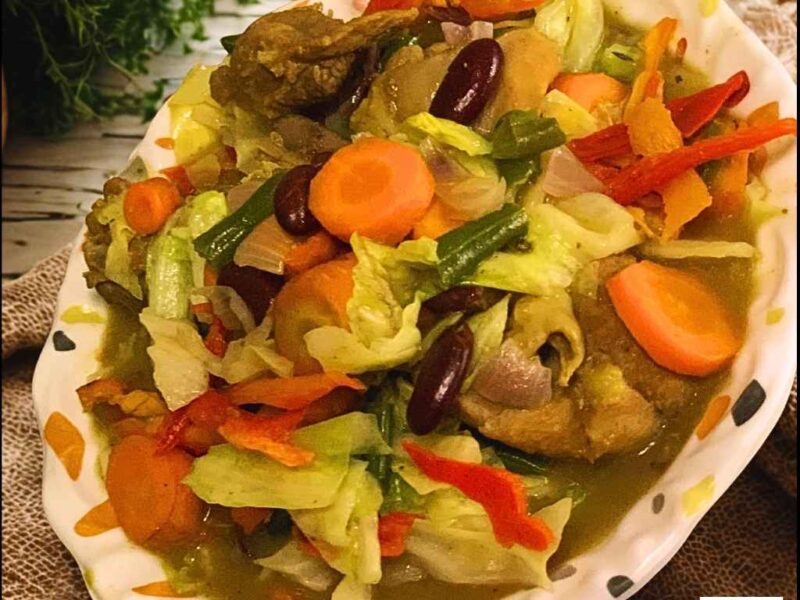

This is so good and on point. Your website is really a place to be.
Thank you for the review. I appreciate.